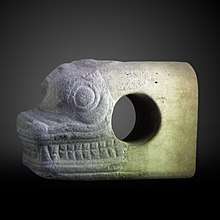Napirisha
Napirisha was an elamite deity from the region of Anshan, and was the main deity of the kingdom from at least the late 3rd Millennium BCE. In Elamite, his name means "Great (-ša) God (napir)"; in cuneiforme texts, the word is written using the ideogramme GAL (meaning "great" in Sumerian), which was without a correct interpretation for some time.

Napirisha is depicted as an anthropomorphic deity, often with a snake figure that symolises primordial waters. It is thus identified with the Mesopotamian god Enki/Ea, who rules the primodial waters of the abyss. In Elam, he was close to the character of Humban, the great god of the Awan region, which he replaced as a titular deity of Elamit kings around 2000 BCE.
In Anshan, Napirisha did not have a main temple. Napirisha was in all likelihood worshiped in large, open stone sanctuaries, such as Kurangun; he is probably the deity depicted on bas-reliefs with his consort (Kiririsha?) and other deities, providing life water. A large temple dedicated to Napirisha was built in Dur-Untash (Choga-Zambil), in Susa, shared with the local titular god Inshushinak. The template was next to a large ziggurat.